The solar system is a system of cosmic bodies, including, in addition to the central luminary - the Sun - eight major planets orbiting around it, their satellites, dwarf planets, minor planets, comets, meteoric bodies moving in the area of the predominant gravitational action of the Sun. The solar system formed about 4.6 billion years ago from a cold cloud of gas and dust. The general structure of the solar system was discovered in the middle of the 16th century by N. Copernicus, who substantiated the concept of the motion of planets around the sun. This model of the solar system is called heliocentric. In the 17th century I. Kepler discovered the laws of planetary motion, and I. Newton formulated the law of universal gravitation. The study of the physical characteristics of cosmic bodies that make up the solar system became possible after the invention of the telescope by G. Galileo in 1609. Observing sunspots, Galileo discovered the rotation of the sun on its axis.
This leads to exposure of people in buildings. The gamma background inside brick, concrete and granite buildings is generally higher than in timber buildings. Global studies show that indoor gamma levels are 20% higher on average than outdoors. It depends on the amount of natural radionuclides in the building materials used and the local external gamma background.
When assessing the average annual effective dose for the population of the Earth, radiation from natural radionuclides occurring in the open air and inside buildings is considered separately. It is assumed that a modern person spends an average of 80% of their time in buildings and 20% of their time outdoors, which means that the natural exposure to the open air during a person's stay in buildings is influenced by outdoor exposure.
Large planets orbiting the Sun form a flat subsystem and are divided into two groups. One of them, internal (or terrestrial), includes Mercury , Venus , Earth , Mars. The outer group of the giant planets includes Jupiter , Saturn , Uranus , Neptune. In the central body of the system - the Sun - 99.866% of its entire mass is concentrated, if we do not take into account the cosmic dust within the solar system, the total mass of which is comparable to the mass of the Sun. The sun is 76% hydrogen; helium is about 3.4 times less, and all other elements account for about 0.75% of the total mass. Similar chemical composition also have giant planets. The planets of the terrestrial group are close in chemical composition to the Earth.
It was found that gamma radiation due to natural radionuclides in earth surface and building materials results in outdoor exposure, which is estimated at 0.5 mSv per year worldwide. The gamma background from outdoor ground radiation changes in rainy weather and snowfall. Snow cover is reduced by about 10-20% of the gamma background in this area due to its shielding effect. Rain of rains of natural terrestrial radionuclides contained in the ground air, and, as a consequence, the gamma background can grow by 20-50% in this area.
Almost all planets have satellites, and about 90% of their number is grouped around the outer planets. Jupiter and Saturn are themselves miniature likenesses of the solar system. Some of their companions (Ganymede , Titan) is larger than the planet Mercury. Saturn, in addition to 30 satellites, also possesses a powerful system of rings, consisting of a huge number of small bodies of ice or silicate nature; the radius of the outer observable ring is approximately 2.3 times the radius of Saturn. With the advent of space methods for planetary exploration (automatic interplanetary stations, space telescopes), rings were also discovered on other giant planets.
The influence of meteorological conditions must always be taken into account when evaluating a galaxy in the field, since the measured instantaneous values can fluctuate within about 50% over a certain period of time. In addition to external radiation, natural background radiation also causes internal radiation when certain naturally occurring radionuclides enter the human body through inhalation and ingestion.
The main radionuclides of the uranium-radiation and thorium family that lead to human exposure are uranium-238, radium-226 and thorium radionuclides of terrestrial origin, entering the human body, inhaling solid particles raised from the earth's surface and swallowing food and water. With the exception of polonium, which accumulates in soft tissues, all other naturally occurring alpha nuclides accumulate mainly in the bones of the human body. Internal exposure of thorium-232 is approximately 3 times less than internal exposure due to uranium.
All the planets of the solar system, in addition to the fact that they, obeying the gravity of the sun, revolve around it, have their own rotation. The Sun also revolves around its axis, although not as a single rigid whole. Measurements based on the Doppler effect show that the rotation speeds of different parts of the sun's surface are slightly different. At 16 ° latitude, the period of full revolution is 25.38 Earth days. The direction of rotation of the Sun coincides with the direction of rotation of the planets and their satellites around it and with the direction of their own rotation of the planets around their axes (with the exception of Venus, Uranus and a number of satellites). The mass of the Sun is 330,000 times the mass of the Earth.
Of the 13 known radium isotopes, the main contribution to internal radiation has a radius of 226, which enters the human body mainly through food. Another important source of natural internal radiation is the potassium-40 radionuclide, which is mainly found in the human body with food. Natural potassium contains two stable isotopes: potassium-39 and potassium-41 and an unstable isotope - potassium-40 with a half-life of 1.3 billion years. Throughout nature, this percentage of the three isotopes of potassium remains unchanged.
All living organisms in nature contain potassium, which is a typical bioelement. Living organisms that absorb potassium do not change its core composition. Potassium is concentrated in human muscles. In young people, the content of potassium or radioactive potassium-40 is about 2 times higher than in older people.
0.83, while of all the major planets, the orbital inclination is relatively large only for Mercury (7 ° 0 "15"), Venus (3 ° 23 "40") and especially Pluto (17 ° 10 "). Among the minor planets of the solar system, Icarus, discovered in 1949 and having a diameter of about 1 km, is of particular interest. Its orbit almost intersects the orbit of the Earth, and with the closest approach of these bodies, the distance between them decreases to 7 million km. Such a rapprochement of Icarus with the Earth occurs once every 19 years.
Cosmogenic radionuclides are formed by the interaction of cosmic radiation with atomic nuclei entering the atmosphere and, to a much lesser extent, by the interaction of atomic nuclei contained in earth crust... About 20 cosmogenic radionuclides are known, of which tritium, carbon-14, beryllium-7, sodium-22, phosphorus-32, sulfur-35, chlorine.
When assessing the radiation in rooms from cosmogenic radionuclides, the radiation impact due to carbon-14 and tritium and for tritium is much lower. Internal radiation caused by radionuclides of cosmogenic origin is insignificant in comparison with internal radiation of radionuclides of terrestrial origin.
Comets form a peculiar group of small bodies. In terms of size, shape and type of trajectories, they differ significantly from the major planets and their satellites. These bodies are small only in mass. The "tail" of a large comet is larger than the sun, while its mass can be only a few thousand tons. Almost all of the comet's mass is concentrated in its core, which, in all likelihood, is the size of a small asteroid. The comet's nucleus consists mainly of frozen gases - methane, ammonia, water vapor and carbon dioxide - interspersed with meteoric particles. Sublimation products of the core under the action solar radiation leave the nucleus and form a cometary tail, which sharply increases when the nucleus passes through perihelion.
Natural radioactive elemental radon with atomic number 86 in the Mendelian table has a natural contribution to the internal radiation of the Earth's population. chemical elements... Therefore, the natural internal radiation caused by radon and its auxiliary products is 4 times higher than the internal radiation caused by natural radionuclides of terrestrial and cosmogenic origin.
Radon is a radioactive inert gas that is heavier than air. It is formed by the alpha decomposition of the atomic nuclei of radium-226, which is a daughter product of the uranium radionuclide family with a uranium source. In turn, the radioactive decomposition of gaseous radon-222 forms a chain of new radioactive products in a solid state. namely polonium-218, polonium-214, bismuth-214 and lead-214. These auxiliary radionuclides adhere to the existing microscopic powder particles in the air and, when inhaled, enter the respiratory system of the human body and remain in it.
As a result of the decay of cometary nuclei, meteor swarms arise, when they meet in earthly atmosphere"showers of shooting stars" are observed. The orbital periods of comets can be as long as millions of years. Sometimes comets move away from the Sun at such huge distances that they begin to experience gravitational disturbances from nearby stars. Only the orbits of a few comets are so disturbed that they become short-period. One of the brightest of these is Halley's comet; the period of its circulation is close to 76 years. The total number of comets in the solar system is estimated in the hundreds of billions.
Internal exposure is associated precisely with the inhaled short-lived products of radon, and not with radon itself, which is an inert gas. From the point of view of radiation protection, all radioactive noble gases are only a source of external radiation, since they are chemically inert in nature and do not enter into biochemical interactions with substances contained in human tissues and organs, and are exhaled from the lungs by exhalation. As a result of many scientific studies, 98% of the internal irradiation of the human body comes from the inhalation of bottom radon compounds acting on the bronchial epithelium, and only 2% is associated with the radioactive decay of radon itself.
Meteoric bodies, like cosmic dust, fill the entire space of the solar system. When meeting the Earth, their speeds reach 70 km / s. Their movement, and especially the movement of cosmic dust, is influenced by gravitational and (to a lesser extent) magnetic fields, as well as fluxes of radiation and particles. Inside the Earth's orbit, the density of cosmic dust increases, and it forms a cloud surrounding the Sun, visible from Earth as zodiacal light. The solar system participates in the rotation of the Galaxy, moving in an approximately circular orbit with a speed of approx. 250 km / s. The period of revolution around the center of the Galaxy is determined at about 200 million years. In relation to the nearest stars, the entire solar system moves on average at a speed of 19.4 km / s.
Natural uranium is distributed throughout the earth's crust, and its content is estimated at an average of 10-4%. Accordingly, radon, as a member of the uranium-radium family, spreads throughout the earth - in soils, rocks, minerals, waters. Some of the radon formed by the natural radium-uranium-radon chain comes from the earth's surface in the atmospheric air. Radon spreading through the air in environment, is carried out through natural diffusion and convection and depends on a number of natural and climatic factors: atmospheric pressure, air temperature, precipitation, wind, relief and other natural features.
Definition and classification of celestial bodies, basic physical and chemical characteristics of astronomical objects in the solar system.
The content of the article:
Celestial bodies are objects located in the Observable Universe. These objects can be natural physical bodies or their associations. All of them are characterized by isolation, and also represent a single structure connected by gravity or electromagnetism. Astronomy is engaged in the study of this category. This article proposes a classification of the celestial bodies of the solar system, as well as a description of their main characteristics.
The concentration of radon in the atmosphere decreases with increasing altitude. In addition, the concentration of radon in the atmospheric air changes depending on climatic season with the highest values being recorded during the summer months. During the day, the concentration of radon in the atmosphere also changes.
Typically, the concentration of radon in buildings is higher and depends on the type of building materials. Table 2 summarizes the radiation exposure of the population of Europe due to natural background radiation. About 40% of this annual effective dose is due to cosmic radiation, and the remaining 60% is due to gamma radiation in buildings and outdoors. The rest of the average annual effective dose for the European population is formed by radon. Internal radiation from radon in countries such as France, Sweden and Finland is 4-7 times higher than external exposure to other natural radioactive sources.
Classification of the celestial bodies of the solar system

Each celestial body has special characteristics, for example, the method of origin, chemical composition, size, etc. This makes it possible to classify objects by combining them into groups. Let us describe what heavenly bodies are in the solar system: stars, planets, satellites, asteroids, comets, etc.
Classification of the celestial bodies of the solar system by composition:
The pressure wave resulting from this explosion caused the particles of dust and gas to move, which formed into rings that revolve around a dense and massive center. A thermonuclear reaction began in it - the sun appeared, and the solar wind appeared, which "blew up" the remaining dust and gas from the Sun to the emerging planets. Small particles in the cloud began to collide and attach to more and more pieces of matter. Then the effects of gravity were created by other objects with many asteroids and even more comets. The Solar System is the planetary system of the Solar Star and is part of the Milky Way Galaxy. It also consists of eight planets, dwarf planets, over 150 months of planets, asteroids, comets, meteorites and other bodies. 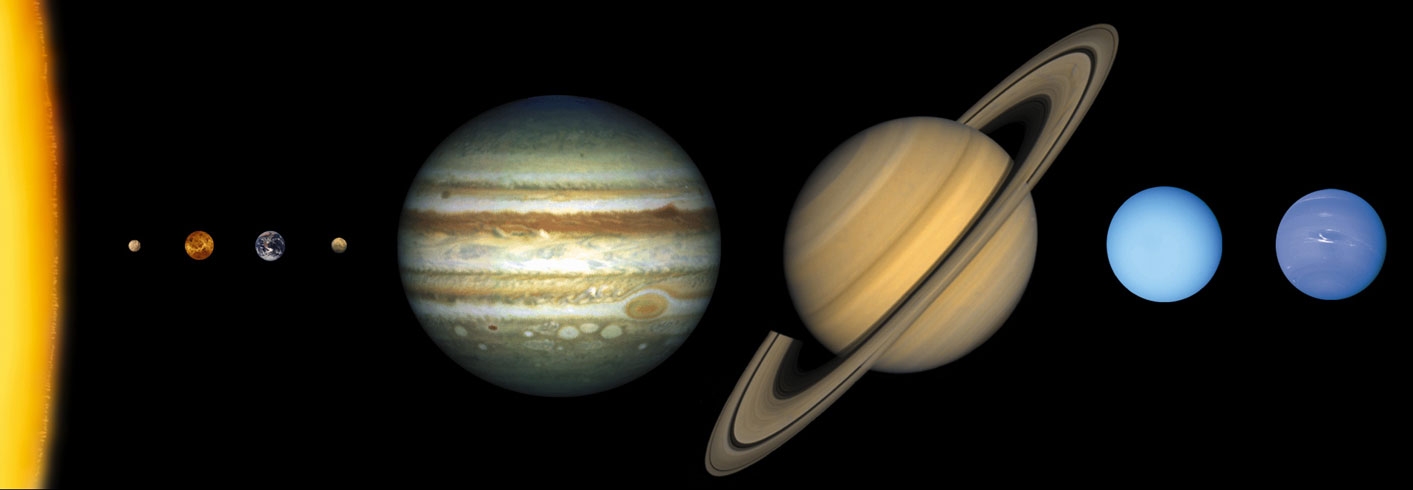
The thermal difference on the planet Mercury is the largest in the solar system, from 90 K on the side of the Sun to 700 K on the side exposed to the sun. Scientists believe that water inside craters near the planet's North Pole can be found. According to University of Texas researchers Dirk Schultz-Makuch and Louise Irwin, the planet may contain the right place for life in the upper atmosphere.
- About 4.6 billion years ago, there was an explosion of nearby supernovae.
- The largest of them became the cornerstones of future planets.
- In addition, the temperature was lower, which led to the emergence of gas giants.
- The solar system is made up of bodies different types and sizes.
- The central body is the Sun, in which almost all of its weight is concentrated.
- The earth circulates around the sun for one year.
- We divide the planet into plant and gaseous ones.
- Mercury is the planet closest to the Sun.
- Mercury is like the Moon.
- Its surface is very old and cratered.
- Silicate celestial bodies... This group of celestial bodies is called silicate, because the main component of all its representatives are stone-metal rocks (about 99% of the total body weight). The silicate component is represented by such refractory substances as silicon, calcium, iron, aluminum, magnesium, sulfur, etc. There are also ice and gas components (water, ice, nitrogen, carbon dioxide, oxygen, helium-hydrogen), but their content is scanty. This category includes 4 planets (Venus, Mercury, Earth and Mars), satellites (Moon, Io, Europa, Triton, Phobos, Deimos, Amalthea, etc.), more than a million asteroids orbiting between the orbits of two planets - Jupiter and Mars (Pallas , Hygea, Vesta, Ceres, etc.). The density indicator is from 3 grams per cubic centimeter or more.
- Icy celestial bodies... This group is the largest in the solar system. The main component is the ice component (carbon dioxide, nitrogen, water ice, oxygen, ammonia, methane, etc.). The silicate component is present in a smaller amount, and the gas volume is extremely insignificant. This group includes one planet Pluto, large satellites (Ganymede, Titan, Callisto, Charon, etc.), as well as all comets.
- Combined celestial bodies... The composition of the representatives of this group is characterized by the presence in large quantities of all three components, i.e. silicate, gas and ice. Celestial bodies with a combined composition include the Sun and giant planets (Neptune, Saturn, Jupiter and Uranus). These objects are characterized by fast rotation.
Characteristics of the star Sun

We would only be successful if we violated the planning rules. The solar system consists of two inner planets, the Earth and five outer planets, five dwarf planets, over 150 months, and other smaller bodies such as asteroids, comets, meteoroids, etc. the planets are located in the so-called main strip on the paths of Mars and Jupiter, the Kuiper Belt for Neptune, or even further. The full edge of our system is a huge reservoir of cometary nuclei.
Planets travel the universe following nearly circular or elliptical paths with the sun in focus. In the same way, they revolve around their planets and moons. The planets are hardly small compared to the distances that separate them. In the last column of the table and on the map, you can compare the distances of the planets on this scale.
The sun is a star, i.e. is a collection of gas with incredible volumes. It has its own gravity (interaction characterized by attraction), with the help of which all its components are held. Inside any star, and hence inside the Sun, thermonuclear fusion reactions occur, the product of which is colossal energy.
The sun has a core, around which a radiation zone is formed, where energy transfer takes place. This is followed by the convection zone, in which magnetic fields and movements of solar matter are generated. The visible part of the Sun can be called the surface of this star only conditionally. A more correct formulation is the photosphere or the sphere of light.
The attraction inside the Sun is so great that a photon from its core takes hundreds of thousands of years to reach the surface of a star. Moreover, its path from the surface of the Sun to the Earth is only 8 minutes. The density and size of the sun allows it to attract other objects in the solar system. The acceleration of gravity (gravity) in the surface area is almost 28 m / s 2.
The characteristic of the celestial body of the star Sun is as follows:
- Chemical composition. The main components of the sun are helium and hydrogen. Naturally, the star includes other elements, but their proportion is very scanty.
- Temperature. The temperature value differs significantly in different zones, so, in the core it reaches 15,000,000 degrees Celsius, and in the visible part - 5,500 degrees Celsius.
- Density. It is 1.409 g / cm 3. The highest density is noted in the core, the lowest - on the surface.
- Weight. If we describe the mass of the Sun without mathematical abbreviations, then the number will look like 1.988.920.000.000.000.000.000.000.000.000 kg.
- Volume. The full value is 1.412.000.000.000.000.000.000.000.000.000 cubic kilograms.
- Diameter. This figure is 1,391,000 km.
- Radius. The radius of the star Sun is 695500 km.
- Orbit of a celestial body. The sun has its own orbit, which runs around the center of the Milky Way. A complete revolution takes 226 million years. Scientists' calculations have shown that the speed of movement is incredibly high - almost 782,000 kilometers per hour.
Characteristics of the planets of the solar system
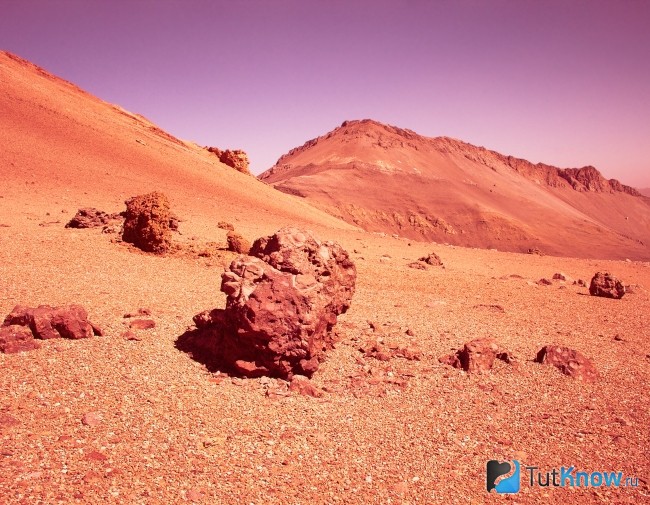
Planets are celestial bodies that orbit around a star or its remnants. Large weight allows planets to become rounded under the influence of their own gravity. However, the size and weight are insufficient for the start of thermonuclear reactions. Let us examine in more detail the characteristics of the planets using the examples of some representatives of this category that are part of the solar system.
Mars is the second most studied planet. It is the 4th farthest from the Sun. Its size allows it to occupy the 7th place in the ranking of the most voluminous celestial bodies in the solar system. Mars has an inner core surrounded by an outer liquid core. Further, the silicate mantle of the planet is located. And after the intermediate layer comes the crust, which has a different thickness in different parts of the celestial body.
Let's take a closer look at the characteristics of Mars:
- The chemical composition of the celestial body. The main elements that make up Mars are iron, sulfur, silicates, basalt, iron oxide.
- Temperature. The average is -50 ° C.
- Density - 3.94 g / cm 3.
- Weight - 641.850.000.000.000.000.000.000 kg.
- Volume - 163.180.000.000 km 3.
- Diameter - 6780 km.
- Radius - 3390 km.
- The acceleration of gravity is 3.711 m / s 2.
- Orbit. Lies around the sun. It has a rounded trajectory, which is far from ideal. v different time the distance of a celestial body from the center of the solar system has different indicators - 206 and 249 million km.
Pluto has the following characteristics:
- Composition. The main ingredients are stone and ice.
- Temperature. The average temperature on Pluto is -229 degrees Celsius.
- Density - about 2 g per 1 cm 3.
- The mass of a celestial body is 13.105.000.000.000.000.000.000 kg.
- Volume - 7,150,000,000 km 3.
- Diameter - 2374 km.
- Radius - 1187 km.
- The acceleration of gravity is 0.62 m / s 2.
- Orbit. The planet revolves around the Sun, but the orbit is characterized by eccentricity, i.e. in one period it moves away to 7.4 billion km, in another - it approaches 4.4 billion km. The orbital speed of a celestial body reaches 4.6691 km / s.
The main characteristics of Uranus:
- Chemical composition. This planet is made up of a combination of chemical elements. In large quantities it includes silicon, metals, water, methane, ammonia, hydrogen, etc.
- Celestial body temperature. average temperature- -224 ° C.
- Density - 1.3 g / cm 3.
- Weight - 86.832.000.000.000.000.000.000 kg.
- Volume - 68.340.000.000 km 3.
- Diameter - 50,724 km.
- Radius - 25362 km.
- The acceleration of gravity is 8.69 m / s 2.
- Orbit. The center around which Uranus revolves is also the Sun. The orbit is slightly elongated. The orbital speed is 6.81 km / s.
Characteristics of the satellites of celestial bodies
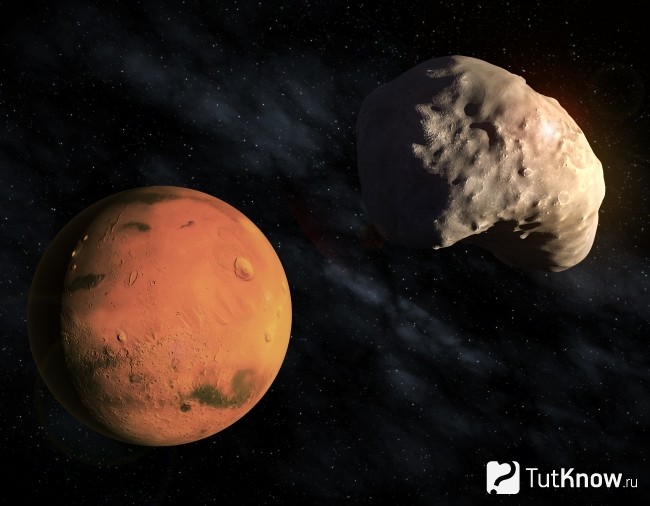
A satellite is an object located in the Visible Universe, which does not revolve around a star, but around another celestial body under the influence of its gravity and along a certain trajectory. Let's describe some satellites and characteristics of these cosmic celestial bodies.
Deimos, a satellite of Mars, which is considered one of the smallest, is described as follows:
- Shape - similar to a triaxial ellipsoid.
- Dimensions - 15x12.2x10.4 km.
- Weight - 1.480.000.000.000.000 kg.
- Density - 1.47 g / cm 3.
- Composition. The satellite mainly includes stony rocks and regolith. The atmosphere is absent.
- The acceleration of gravity is 0.004 m / s 2.
- Temperature - -40 ° С.
Callisto's characteristics:
- The shape is round.
- Diameter - 4820 km.
- Weight - 107.600.000.000.000.000.000.000 kg.
- Density - 1.834 g / cm 3.
- Composition - carbon dioxide, molecular oxygen.
- The acceleration of gravity is 1.24 m / s 2.
- Temperature - -139.2 ° C.
Consider the characteristics of Oberon:
- The shape is round.
- Diameter - 1523 km.
- Weight - 3.014.000.000.000.000.000.000 kg.
- Density - 1.63 g / cm 3.
- Composition - stone, ice, organic matter.
- The acceleration of gravity is 0.35 m / s 2.
- Temperature - -198 ° C.
Characteristics of asteroids in the solar system
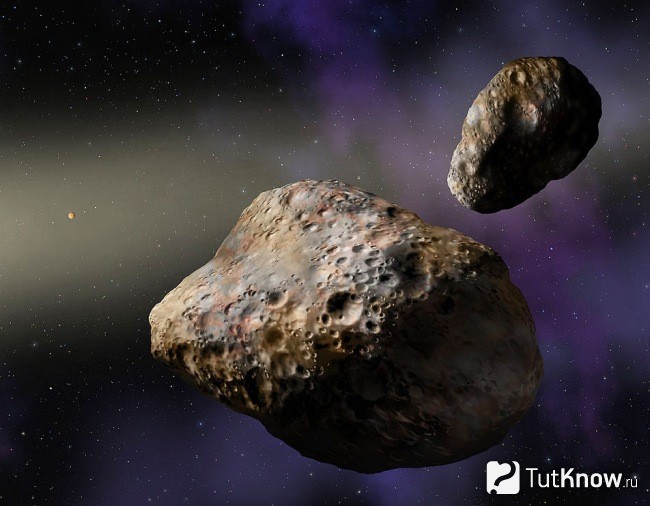
Asteroids are large boulders. Mostly located in the asteroid belt between the orbits of Jupiter and Mars. They can go out of their orbits towards the Earth and the Sun.
A striking representative of this class is Hygea - one of the largest asteroids. This celestial body is located in the main asteroid belt. You can even see it with binoculars, but not always. It is well distinguishable during the perihelion period, i.e. at the moment when the asteroid is at the point of its orbit closest to the Sun. Has a dull dark surface.
Main characteristics of Hygea:
- Diameter - 4 07 km.
- Density - 2.56 g / cm 3.
- Weight - 90.300.000.000.000.000.000 kg.
- The acceleration of gravity is 0.15 m / s 2.
- Orbital speed. The average value is 16.75 km / s.
The main characteristics of Matilda are as follows:
- The diameter is almost 53 km.
- Density - 1.3 g / cm 3.
- Weight - 103.300.000.000.000.000 kg.
- The acceleration of gravity is 0.01 m / s 2.
- Orbit. Matilda passes full turn in orbit in 1572 Earth days.
This asteroid has an iron-nickel core covered with a stone mantle. The largest crater on Vesta is 460 km long and 13 km deep.
We list the main physical characteristics of Vesta:
- Diameter - 525 km.
- Weight. The value is in the range of 260.000.000.000.000.000.000 kg.
- The density is about 3.46 g / cm 3.
- Free fall acceleration - 0.22 m / s 2.
- Orbital speed. The average orbital speed is 19.35 km / s. One revolution around the Vesta axis takes 5.3 hours.
Characteristics of comets of the solar system
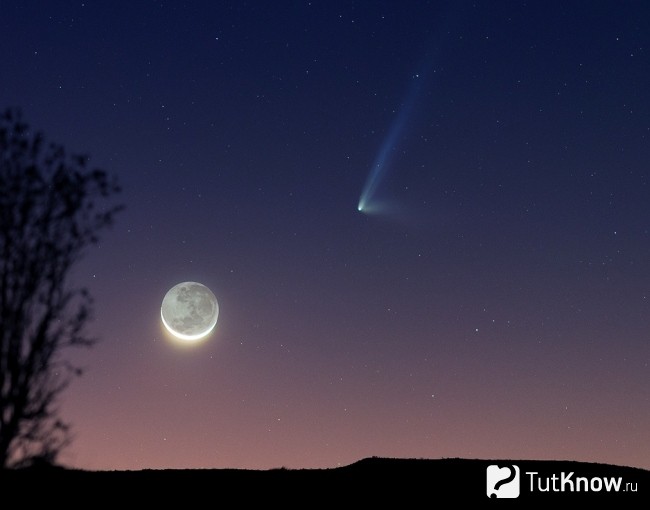
A comet is a small celestial body. The orbits of comets pass around the Sun and have an elongated shape. These objects, approaching the Sun, form a trail consisting of gas and dust. Sometimes it remains in the form of a coma, i.e. a cloud that stretches over a huge distance - from 100,000 to 1.4 million km from the comet's nucleus. In other cases, the trail remains in the form of a tail, the length of which can reach 20 million km.
Halley is the celestial body of a group of comets, known to mankind since ancient times, because it can be seen with the naked eye.
Halley characteristics:
- Weight. Approximately equal to 220.000.000.000.000 kg.
- Density - 600 kg / m 3.
- The period of revolution around the Sun is less than 200 years. Approximately 75-76 years later it will approach the star.
- Composition - frozen water, metal and silicates.
The composition of the comet: deuterium (heavy water), organic compounds (formic, acetic acid, etc.), argon, crypto, etc. The period of revolution around the Sun is 2534 years. There are no reliable data on the physical characteristics of this comet.
Comet Tempel is famous for being the first comet to the surface of which a probe was delivered from Earth.
Characteristics of Comet Tempel:
- Weight - within 79.000.000.000.000 kg.
- Dimensions. Length - 7.6 km, width - 4.9 km.
- Composition. Water, carbon dioxide, organic compounds, etc.
- Orbit. Changes during the passage of a comet near Jupiter, gradually decreasing. Latest data: one revolution around the Sun is 5.52 years.
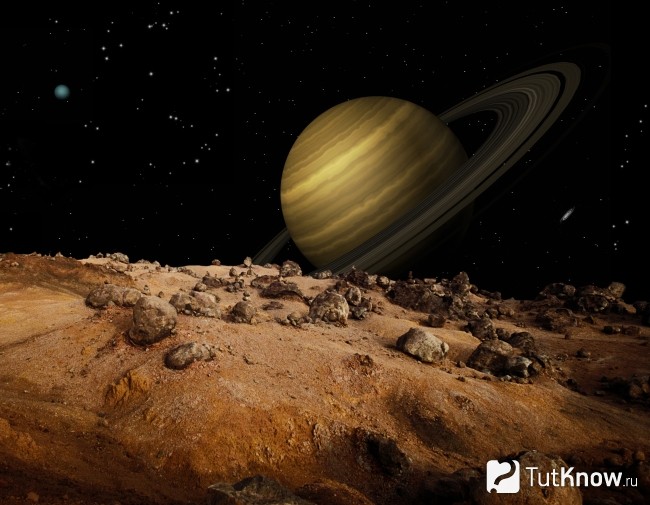
Over the years of studying the solar system, scientists have collected a lot interesting facts about heavenly bodies. Consider those that depend on chemical and physical characteristics:
- The largest celestial body in terms of mass and diameter is the Sun, in second place is Jupiter, and in third place is Saturn.
- The greatest gravity is inherent in the Sun, the second is Jupiter, and the third is Neptune.
- Jupiter's gravity contributes to the active attraction of space debris. Its level is so high that the planet is capable of pulling debris from the Earth's orbit.
- The hottest celestial body in the solar system is the sun - this is no secret to anyone. But the next figure of 480 degrees Celsius is recorded on Venus - the second most distant planet from the center. It would be logical to assume that the second place should be at Mercury, which orbit is closer to the Sun, but in fact the temperature indicator there is lower - 430 ° С. This is due to the presence of Venus and the absence of an atmosphere in Mercury, which is able to retain heat.
- The coldest planet is Uranus.
- To the question of which celestial body has the highest density within the solar system, the answer is simple - the density of the Earth. In second place is Mercury, and in third is Venus.
- The trajectory of the orbit of Mercury provides the duration of a day on the planet, equal to 58 Earth days. The duration of one day on Venus is equal to 243 Earth days, while the year lasts only 225.
The study of the characteristics of celestial bodies allows mankind to make interesting discoveries, substantiate certain patterns, and also expand general knowledge about the Universe.




